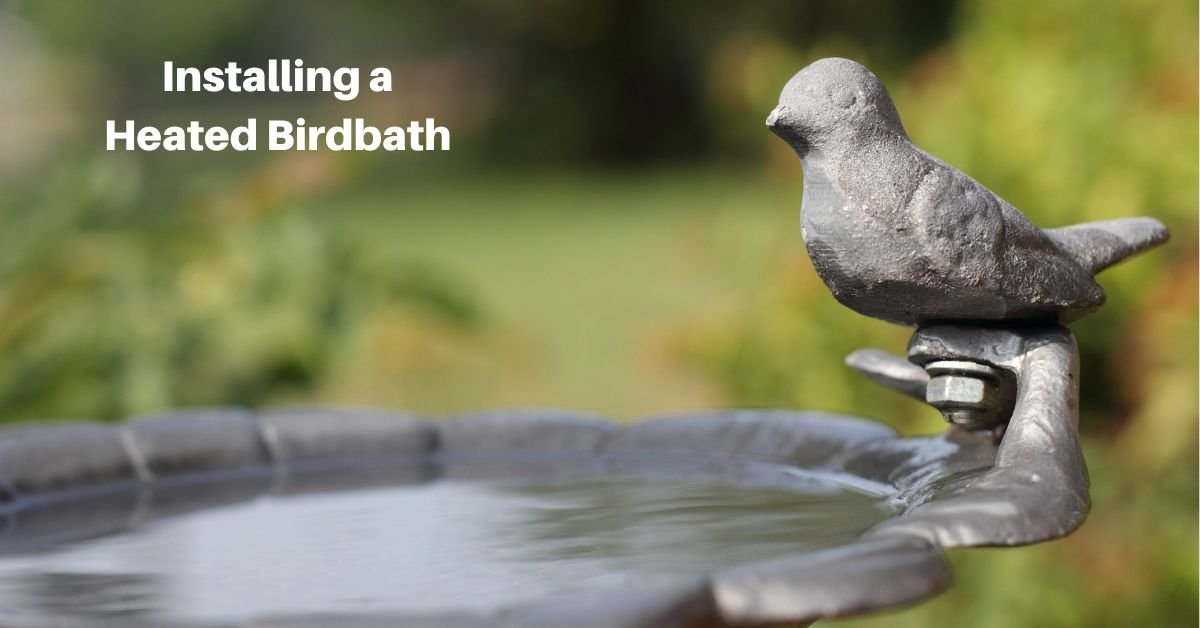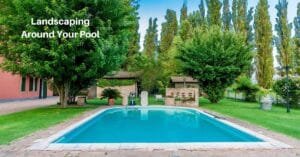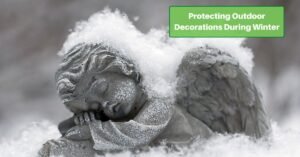A heated birdbath is an excellent addition to any garden where water sources can freeze during winter. By providing birds with a reliable water source year-round, you attract a variety of species to your backyard and help them survive. In this article, we’ll discuss the benefits of a heated birdbath and how to choose the right one for your needs. Most importantly, we’ll provide a step-by-step guide to installing and maintaining it.
Benefits of a Heated Birdbath
Provides Essential Water for Birds
Natural water sources can become scarce during the winter due to freezing temperatures. A heated birdbath ensures that birds have access to fresh, unfrozen water, which they need for both drinking and bathing. This helps them keep their feathers in good condition and stay hydrated.
Attracts a Variety of Bird Species
A heated birdbath can attract a wide range of bird species to your garden. While some species may have flown south for the winter, others stick around. Some others may even end their migration to your area because it’s more hospitable than their summer home.
Other water sources freeze over, so these birds will welcome your contribution! This will make your garden a haven for local wildlife and let you enjoy birdwatching from the comfort of your home.
Supports Bird Health and Hygiene
Birds need water to keep their feathers clean and in good condition. A heated birdbath provides them a safe place to bathe, helping remove dirt and parasites from their plumage. Clean feathers are essential for insulation and flight, especially in colder weather.
Choosing the Right Heated Birdbath
Types of Heated Birdbaths
There are two basic types of heated birdbaths to choose from, depending on your preferences and the climate in your area. You could choose one with the heater built-in or add a de-icer to an existing birdbath:
- Integrated Heated Birdbaths: These birdbaths have a built-in heating element that keeps the water from freezing. They are available in various styles and materials, including ceramic, metal, and plastic.
- Birdbath Heaters or De-Icers: If you already have a birdbath, you can purchase a separate heater or de-icer to keep the water from freezing. These devices are designed to be placed in the birdbath and can be removed during the warmer months.
Material and Durability
When selecting a heated birdbath, consider the material and its durability. Heated birdbaths are typically made from materials like metal, stone, or heavy-duty plastic. Each material has its advantages:
- Metal Birdbaths: Metal birdbaths, such as those made of cast iron or aluminum, are durable and can withstand harsh weather conditions. However, they may be prone to rust if not correctly maintained.
- Stone Birdbaths: Stone birdbaths are sturdy and can blend seamlessly with natural landscapes. They retain heat well, making them an excellent choice for colder climates.
- Plastic Birdbaths: Plastic birdbaths are lightweight, easy to clean, and typically more affordable. However, they may not be as durable as metal or stone options and could become brittle in frigid temperatures.
Power Source and Safety Features
Heated birdbaths can be powered by electricity or solar energy. Electric models usually come with a power cord that needs to be plugged into an outdoor outlet. Ensure that the birdbath has safety features such as an automatic shut-off to prevent overheating and protect the birds. Of course, you’ll need an accessible outlet to use this type!
Solar-powered birdbaths use solar panels to generate heat and are a more eco-friendly option. However, they may be less effective in areas with limited sunlight during winter.
Step-by-Step Installation Guide
Choose the Location
Select a suitable location for your heated birdbath. Ideally, it should be placed in a sheltered spot, away from strong winds and predators. Birds prefer open areas where they can see any approaching danger. Still, the birdbath should also be close enough to shrubs or trees that provide cover.
Prepare the Ground
Ensure the ground where you plan to place the birdbath is level and stable. If necessary, clear away debris or smooth out uneven ground. If using a pedestal-style birdbath, ensure the base is secure and will not tip over easily. For ground-level birdbaths, consider placing it on a flat, solid surface like a patio stone or a piece of wood to prevent it from sinking into the soil.
Install the Birdbath
If you’re using an integrated heated birdbath, place it in the chosen location and ensure it is stable.
If you’re using a separate heater or de-icer, follow the manufacturer’s instructions for installation. Most heaters are designed to be placed in the center of the birdbath, submerged in water.
Connect the Power Source
For electric birdbaths or heaters, plug the power cord into a nearby outdoor outlet. Ensure the cord is properly rated for outdoor use and protected from the elements. If the cord does not reach the outlet, use a heavy-duty, weatherproof extension cord.
For solar-powered birdbaths, position the solar panel in a location that receives direct sunlight for most of the day.
Fill with Water
Fill the birdbath with clean, fresh water. The water level should be shallow, no more than 2 inches deep, to allow birds to drink and bathe safely. Check the water level regularly and refill as needed, especially during periods of freezing temperatures when evaporation can occur more quickly.
Monitor and Maintain
Check your heated birdbath regularly to ensure it is functioning properly. Clean the birdbath frequently to prevent algae growth and debris buildup. If you notice any issues with the heating element or power supply, address them immediately to ensure the birdbath remains a reliable water source for birds. The next section will provide some maintenance tips!
Maintenance and Troubleshooting for Your Heated Birdbath
Once you install your heated birdbath, you still need to provide regular maintenance to keep it functioning properly and providing a clean, safe water source for birds. Here are some essential caretaking tips!
Regular Cleaning
Debris, dirt, and algae will accumulate in the water, making it less appealing and potentially harmful to birds. These steps will help keep your birdbath clean:
- Empty and Scrub: Regularly empty the birdbath and scrub it with a stiff brush to remove dirt, algae, and any other buildup. Avoid using soap or detergents, as these can leave residues harmful to birds. Instead, use a solution of one part white vinegar to nine parts water. Rinse thoroughly after scrubbing to ensure no vinegar remains.
- Change the Water Frequently: Refill the birdbath with fresh water every few days or more often if you notice dirt or debris accumulating quickly. This helps prevent algae growth and ensures that birds can access clean water.
- Remove Ice: While the heater in your birdbath prevents water from freezing, ice can still form around the edges or on the surface. Remove any ice buildup to ensure the heater remains effective and the water stays accessible for birds.
Check the Heater Regularly
Inspect the heating element of your birdbath frequently to ensure it is working correctly. Look for signs of wear, corrosion, or damage to the heating element, and make sure the water temperature is staying above freezing. If you notice any issues, consult the manufacturer’s guidelines for troubleshooting or replacement.
Monitor Water Levels
Water in the birdbath will evaporate even during the winter, especially with a heating element in use. Check the water level regularly and refill as needed to prevent the heater from running dry.
If the heater runs when dry, it can be damaged or even pose a fire risk. Make sure the birdbath always has enough water to cover the heating element.
Protect the Power Source
If you’re using an electrically heated birdbath, regularly inspect the power cord and connections to ensure they are in good condition and free from wear or damage. Ensure the outlet and extension cords are weatherproof and rated for outdoor use. Keep cords off the ground and away from water to reduce the risk of electrical hazards.
Troubleshooting Common Issues
Heater Not Working
If the heater in your birdbath is not working, check the following:
- Power Supply: Ensure the birdbath is plugged in and receiving power. Check the outlet and extension cords for any signs of damage or wear. If using a solar-powered heater, ensure the solar panel gets enough sunlight.
- Temperature Settings: Some heaters have adjustable temperature settings. Ensure the heater is set to the appropriate temperature to prevent the water from freezing.
- Heater Element: If the heater appears to be malfunctioning, inspect the heating element for any signs of damage or wear. If necessary, replace the heating element according to the manufacturer’s instructions.
Water Freezing Despite the Heater
If your birdbath is freezing despite having a heater, consider the following:
- Check the Wattage: Make sure the heater has enough wattage to keep the water from freezing in your climate. Some heaters are designed for milder winters and may not be effective in extremely cold temperatures.
- Increase Water Depth: Adding more water to the birdbath can help maintain a more stable temperature, preventing it from freezing too quickly. However, ensure the water level does not exceed 2 inches so that the birds stay safe.
- Move to a More Sheltered Location: Wind and cold exposure can cause the water to freeze more quickly. Moving the birdbath to a more sheltered location, such as near a wall or under a tree, can help reduce wind chill and keep the water warmer. However, be careful to balance the increased risk of debris or lack of sunlight for a solar-powered heater against the benefits of these locations.
Birds Not Using the Birdbath
If birds are not visiting your heated birdbath, consider the following:
- Placement: Ensure the birdbath is in a safe, visible location where birds feel comfortable. Avoid placing it too close to thick shrubs or areas where predators might hide.
- Water Cleanliness: Birds are less likely to use a birdbath if the water is dirty or stagnant. Keep the water fresh and clean to attract more birds.
- Surrounding Habitat: Birds are more likely to visit a birdbath if nearby trees or shrubs are available for shelter and perching. Consider adding plants or branches nearby to make the area more inviting.
Enhancing Your Birdbath Experience
A heated birdbath can be more than just a water source—it can also be a beautiful and interactive feature in your garden. Here are some ideas to enhance your birdbath experience:
Adding Decorative Elements
Decorate your birdbath with natural stones, pebbles, or small branches to create a more appealing environment for birds. These elements provide perches for birds to land on and make the birdbath more visually interesting.
Creating a Safe Space
Consider adding a small mesh cover to make the birdbath safer for birds. We already mentioned adding perches to beautify the space, but they can also make it safer for your feathered friends.
Combining with Bird Feeders
Pair your heated birdbath with nearby bird feeders to create a welcoming oasis for birds. Providing food nearby can attract a wider variety of bird species to your garden, enhancing your birdwatching experience.
Using a Dripper or Fountain
Adding a dripper or small fountain to your birdbath can create moving water, which is more attractive to birds and helps prevent the water from freezing. The sound of running water also adds a soothing element to your garden.
Seasonal Adjustments
As winter progresses and temperatures change, be prepared to adjust your birdbath’s placement, water level, or heating element as needed. This will ensure that your birdbath continues to provide a reliable water source for birds throughout the season.
Following these tips and maintaining your heated birdbath can create a welcoming and safe environment for birds during the winter months. Not only will you be helping wildlife survive in harsh conditions, but you’ll also enjoy the beauty and activity of birds in your garden all year round.









